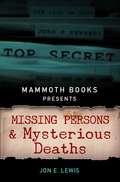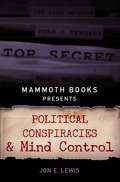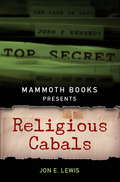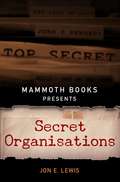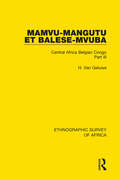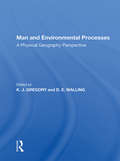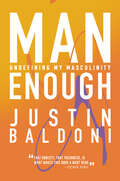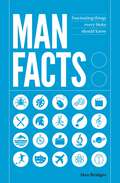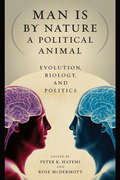- Table View
- List View
Mammoth Books presents Missing Persons and Mysterious Deaths
by Jon E. LewisThis mammoth book brings together some of the modern world's most head-scratching deaths and disappearances, from the murder of rap royalty Tupac Shakur to Princess Diana's car crash in Paris, via the poisoning of former Russian spy Alexander Litvinenko and JFK's assassination.Is it possible that prisoners of war remain left behind in Vietnam? Could the most famous musician in the world stage his own death and recede into an ordinary life? Investigating these quesitons and more, this book is an A-Z of unsolved mysteries, cover-ups, conspiracies and bizarre crimes, bringing together famous names as disparate as Tupac, Elvis, Dr David Kelly, Malcolm X and Wolfgang Amadeus Mozart.
Mammoth Books presents Missing Persons and Mysterious Deaths (Mammoth Books #361)
by Jon E. LewisThis mammoth book brings together some of the modern world's most head-scratching deaths and disappearances, from the murder of rap royalty Tupac Shakur to Princess Diana's car crash in Paris, via the poisoning of former Russian spy Alexander Litvinenko and JFK's assassination.Is it possible that prisoners of war remain left behind in Vietnam? Could the most famous musician in the world stage his own death and recede into an ordinary life? Investigating these quesitons and more, this book is an A-Z of unsolved mysteries, cover-ups, conspiracies and bizarre crimes, bringing together famous names as disparate as Tupac, Elvis, Dr David Kelly, Malcolm X and Wolfgang Amadeus Mozart.
Mammoth Books presents Political Conspiracies and Mind Control
by Jon E. LewisEveryone loves a good conspiracy. From the Jonestown massacre and the Philadelphia experiment to Nazi gold and the moon landing, there are umpteen conspiracy theories that even the least sceptical of us can recall and discuss at length. Entire libraries have been furnished and internet forums filled with this cultural phenomenon in which complex threads are weaved together to explain seismic events in our recent history. Indeed, there are few things more captivating than a well-research, convincing argument that flies in the face of perceived knowledge. So follow Jon E. Lewis down the rabbit hole and look at our political system from a different perspective. Controversies include: - Bar Codes - Can it really be that these codes apparently indicate 666; the mark of the devil and his coming cashless economy?- The Bilderberg Group - An annual polite discussion on current affairs or a forum in which policy with worldwide implications is shaped? - Bohemian Grove - To some, this is a private camping site dubbed 'the greatest men's party on earth', while other's regard it as opportunity to win friends in high places and to secure jobs or contracts. What really goes on at Bohemian Grove when the elite gather?- Bush-Bin Laden Connection - Is it possible that George W. Bush made errors of judgement pre 9/11 because of his family's ties to the Bin Laden's? Is it possible that 9/11 could have been prevented?- Cancer - Is there a cancer cure which is being suppressed by pharmaceutical companies and the medical establishments to keep their multibillion-dollar industry thriving?- Club of Rome - Is it true that the Club of Rome wish to use war, disease and famine as the main ways to eliminate "useless eaters"?- Jonestown - Was this a mass suicide, or was it mass murder intended to cover-up mind-control experiments?- 1969 Moon Landing Hoax - Were all the Apollo landings an astronomical hoax?- Nazi Gold - Did US authorities turn a blind eye to $3 million stolen by its own troops?- Philadelphia Experiment - Did the US Navy cover up invisibility experiments which went hideously wrong?- Ronald Reagan - Did George Bush seek to assassinate Ronald Reagan?- The Royal Institute of International Affairs- To what extent do they influence world agendas?- Star Gate - What is the truth behind the CIA's psi-operations in the 1970s?
Mammoth Books presents Political Conspiracies and Mind Control (Mammoth Books #362)
by Jon E. LewisEveryone loves a good conspiracy. From the Jonestown massacre and the Philadelphia experiment to Nazi gold and the moon landing, there are umpteen conspiracy theories that even the least sceptical of us can recall and discuss at length. Entire libraries have been furnished and internet forums filled with this cultural phenomenon in which complex threads are weaved together to explain seismic events in our recent history. Indeed, there are few things more captivating than a well-research, convincing argument that flies in the face of perceived knowledge. So follow Jon E. Lewis down the rabbit hole and look at our political system from a different perspective. Controversies include: - Bar Codes - Can it really be that these codes apparently indicate 666; the mark of the devil and his coming cashless economy?- The Bilderberg Group - An annual polite discussion on current affairs or a forum in which policy with worldwide implications is shaped? - Bohemian Grove - To some, this is a private camping site dubbed 'the greatest men's party on earth', while other's regard it as opportunity to win friends in high places and to secure jobs or contracts. What really goes on at Bohemian Grove when the elite gather?- Bush-Bin Laden Connection - Is it possible that George W. Bush made errors of judgement pre 9/11 because of his family's ties to the Bin Laden's? Is it possible that 9/11 could have been prevented?- Cancer - Is there a cancer cure which is being suppressed by pharmaceutical companies and the medical establishments to keep their multibillion-dollar industry thriving?- Club of Rome - Is it true that the Club of Rome wish to use war, disease and famine as the main ways to eliminate "useless eaters"?- Jonestown - Was this a mass suicide, or was it mass murder intended to cover-up mind-control experiments?- 1969 Moon Landing Hoax - Were all the Apollo landings an astronomical hoax?- Nazi Gold - Did US authorities turn a blind eye to $3 million stolen by its own troops?- Philadelphia Experiment - Did the US Navy cover up invisibility experiments which went hideously wrong?- Ronald Reagan - Did George Bush seek to assassinate Ronald Reagan?- The Royal Institute of International Affairs- To what extent do they influence world agendas?- Star Gate - What is the truth behind the CIA's psi-operations in the 1970s?
Mammoth Books presents Religious Cabals
by Jon E. LewisThe Dead Sea ScrollsWhy was it so important these documents should not be seen? What ancient historical secret was so big that it had to be buried forever?FreemasonsIs this group of seemingly innocuous middle-aged men linked to almost every evil perpetuated? Are they really just an eccentric bunch of patriarchal do-gooders, or are they in fact sinister agents of satanic forces?The Gunpowder PlotWhy is it that we reserve particular scorn for Guy Fawkes when there were six other men involved?Knights TemplarThe Knights Templar allegedly found the Holy Grail in their excavations of the temple in Jerusalem. Did they survive the cull of the 14th century and live on today as guardians of the Holy Grail?Opus DeiIf Opus Dei's only aims are charity and the 'sanctifying of work', why does it need its secretive independent status as a personal prelature?Pope John Paul IOn the 26th August 1978 a new pope was elected. 33 days later this man was found dead, leaving an alarming trail of inconsistencies and seeming lies told by the Vatican themselves. Why was there no post-mortem, and why within twenty-four hours was his body embalmed?The Priory of SionDoes this French secret society protect the blood-line of Christ?The Protocols of the Learned Elders of ZionThe truth behind the book in which powerful Jews supposedly set out the secret means to rule the Christian world.The Rosicrucian'sDoes this philosophical secret society seek to take over the world?Satanic Ritual AbuseSatanists ritually abuse children and nobody has the power to prevent it due to their infiltration into the police force and politics.The Temple Mount PlotAre Freemason's and Jews collaborating in a plot to destroy Islamic holy sites on Jerusalem's Temple Mount?
Mammoth Books presents Religious Cabals (Mammoth Books #363)
by Jon E. LewisThe Dead Sea ScrollsWhy was it so important these documents should not be seen? What ancient historical secret was so big that it had to be buried forever?FreemasonsIs this group of seemingly innocuous middle-aged men linked to almost every evil perpetuated? Are they really just an eccentric bunch of patriarchal do-gooders, or are they in fact sinister agents of satanic forces?The Gunpowder PlotWhy is it that we reserve particular scorn for Guy Fawkes when there were six other men involved?Knights TemplarThe Knights Templar allegedly found the Holy Grail in their excavations of the temple in Jerusalem. Did they survive the cull of the 14th century and live on today as guardians of the Holy Grail?Opus DeiIf Opus Dei's only aims are charity and the 'sanctifying of work', why does it need its secretive independent status as a personal prelature?Pope John Paul IOn the 26th August 1978 a new pope was elected. 33 days later this man was found dead, leaving an alarming trail of inconsistencies and seeming lies told by the Vatican themselves. Why was there no post-mortem, and why within twenty-four hours was his body embalmed?The Priory of SionDoes this French secret society protect the blood-line of Christ?The Protocols of the Learned Elders of ZionThe truth behind the book in which powerful Jews supposedly set out the secret means to rule the Christian world.The RosicruciansDoes this philosophical secret society seek to take over the world?Satanic Ritual AbuseSatanists ritually abuse children and nobody has the power to prevent it due to their infiltration into the police force and politics.The Temple Mount PlotAre Freemason's and Jews collaborating in a plot to destroy Islamic holy sites on Jerusalem's Temple Mount?
Mammoth Books presents Secret Organisations
by Jon E. LewisBlack HelicoptersBlack helicopters are believed by some to be used for the surveillance of patriotic groups opposed to the takeover of the United States by foreign powers. Those sinister, silent, Black Hawk Down-style copters are hard to miss, but what exactly is their role?The British Royal FamilyAccording to Lyndon LaRouche, the British royal family are imperial masters of the planet. Is it possible that Satan lives in Buckingham Palace?The IlluminatiSo powerful are the Illuminati that they are said to mastermind events and completely control world affairs, but how much do we actually know about them?Le CercleA transnational, clandestine cabal of influential individuals, the group prides itself on complete anonymity. Only a handful of articles are known to have been written about the group, so what do we really know about them?MK-ULTRAWhat went on under MK-ULTRA? And did anybody ever receive reasonable compensation?New World OrderHow powerful is this group that seek to enable a one-world government?Omega AgencyThe Omega Agency and its allies, the aliens, are devising a plan to restore the planet's environment after the OA take over New World Order dictatorship.P2 (Propaganda Due)Did P2 set out a plan for a fascist coup in which unions would be banned and the media would be placed under state control?Skull and Bones"It's so secret we can't talk about it," George W. Bush said on the membership of Skull & Bones. Does this organisation control the US?
Mammoth Books presents Secret Organisations (Mammoth Books #364)
by Jon E. LewisBlack HelicoptersBlack helicopters are believed by some to be used for the surveillance of patriotic groups opposed to the takeover of the United States by foreign powers. Those sinister, silent, Black Hawk Down-style copters are hard to miss, but what exactly is their role?The British Royal FamilyAccording to Lyndon LaRouche, the British royal family are imperial masters of the planet. Is it possible that Satan lives in Buckingham Palace?The IlluminatiSo powerful are the Illuminati that they are said to mastermind events and completely control world affairs, but how much do we actually know about them?Le CercleA transnational, clandestine cabal of influential individuals, the group prides itself on complete anonymity. Only a handful of articles are known to have been written about the group, so what do we really know about them?MK-ULTRAWhat went on under MK-ULTRA? And did anybody ever receive reasonable compensation?New World OrderHow powerful is this group that seek to enable a one-world government?Omega AgencyThe Omega Agency and its allies, the aliens, are devising a plan to restore the planet's environment after the OA take over New World Order dictatorship.P2 (Propaganda Due)Did P2 set out a plan for a fascist coup in which unions would be banned and the media would be placed under state control?Skull and Bones"It's so secret we can't talk about it," George W. Bush said on the membership of Skull & Bones. Does this organisation control the US?
Mammoth Books presents Terrorist Attacks and Clandestine Wars
by Jon E. Lewis7/7Is the government covering up evidence of bungling by the intelligence services before the 7/7 bombings in London?9/11Did George Bush stage the 9/11 attack, or at least purposefully allow for it to occur so he could generate support to invade Afghanistan for reasons linked to the oil industry? And was Flight 93 shot down on the order of the White House before it could reach its target? Or was it really al-Qaeda acting alone?HAARPIt is said that HAARP camouflages the most destructive weapon ever created. Is it really possible that this is what this 33-acre site is concealing?The Lockerbie BombingInitially it was assumed that Libya had a clear motive for the Lockerbie bombing, revenge for the 1986 US Air Force raid on the cities of Tripoli and Benghazi. But the truth is inevitably far more complex.The Madrid Train BombingsWhat is the truth behind this atrocity in Spain?Oklahoma City BombingsIs the fact that the FBI failed to investigate McVeigh's connections with the Militias, and the fact that they held back 3,000 pages of documents enough to prove the Oklahoma City bombing was orchestrated by them?Pearl HarborDid President Franklin D. Roosevelt conspire to bring about the attack on US forces at Pearl Harbour?The Port Chicago ExplosionWhat was the real cause of this explosion?The Rainbow WarriorFrench DGSE agents alleged to have sunk this Greenpeace ship. How much of this is true, and if it is, why did they do it?Roberto CalviIn 1982 "God's banker" was found dead, swinging from Blackfriars Bridge in London. As Calvi had been under enormous pressure it was assumed he had killed himself. But twenty years on, the case was reopened and revaluated, producing somewhat different findings.The Sovereign Military Order of MaltaDoes the Order moonlight as an intelligence broker?TWA Flight 800Why did this plane explode over the Atlantic?
Mammoth Books presents Terrorist Attacks and Clandestine Wars (Mammoth Books #365)
by Jon E. Lewis7/7Is the government covering up evidence of bungling by the intelligence services before the 7/7 bombings in London?9/11Did George Bush stage the 9/11 attack, or at least purposefully allow for it to occur so he could generate support to invade Afghanistan for reasons linked to the oil industry? And was Flight 93 shot down on the order of the White House before it could reach its target? Or was it really al-Qaeda acting alone?HAARPIt is said that HAARP camouflages the most destructive weapon ever created. Is it really possible that this is what this 33-acre site is concealing?The Lockerbie BombingInitially it was assumed that Libya had a clear motive for the Lockerbie bombing, revenge for the 1986 US Air Force raid on the cities of Tripoli and Benghazi. But the truth is inevitably far more complex.The Madrid Train BombingsWhat is the truth behind this atrocity in Spain?Oklahoma City BombingsIs the fact that the FBI failed to investigate McVeigh's connections with the Militias, and the fact that they held back 3,000 pages of documents enough to prove the Oklahoma City bombing was orchestrated by them?Pearl HarborDid President Franklin D. Roosevelt conspire to bring about the attack on US forces at Pearl Harbour?The Port Chicago ExplosionWhat was the real cause of this explosion?The Rainbow WarriorFrench DGSE agents alleged to have sunk this Greenpeace ship. How much of this is true, and if it is, why did they do it?Roberto CalviIn 1982 "God's banker" was found dead, swinging from Blackfriars Bridge in London. As Calvi had been under enormous pressure it was assumed he had killed himself. But twenty years on, the case was reopened and revaluated, producing somewhat different findings.The Sovereign Military Order of MaltaDoes the Order moonlight as an intelligence broker?TWA Flight 800Why did this plane explode over the Atlantic?
Mamvu-Mangutu et Balese-Mvuba: Central Africa Belgian Congo Part III
by H. Van GeluweRoutledge is proud to be re-issuing this landmark series in association with the International African Institute. The series, published between 1950 and 1977, brings together a wealth of previously un-co-ordinated material on the ethnic groupings and social conditions of African peoples. Concise, critical and (for its time) accurate, the Ethnographic Survey contains sections as follows: Physical Environment Linguistic Data Demography History & Traditions of Origin Nomenclature Grouping Cultural Features: Religion, Witchcraft, Birth, Initiation, Burial Social & Political Organization: Kinship, Marriage, Inheritance, Slavery, Land Tenure, Warfare & Justice Economy & Trade Domestic Architecture Each of the 50 volumes will be available to buy individually, and these are organized into regional sub-groups: East Central Africa, North-Eastern Africa, Southern Africa, West Central Africa, Western Africa, and Central Africa Belgian Congo. The volumes are supplemented with maps, available to view on routledge.com or available as a pdf from the publishers.
Man & Animals In New Hebrides
by BakerFirst published in 2005. Routledge is an imprint of Taylor & Francis, an informa company.
Man And Environmental Processes: A Physical Geography Perspective (Studies In Physical Geography)
by K. J. GregoryThe aim of the present volume is to review the effects of human activity on physical environment processes, and this is justified not only as a complement to the approach taken by G. P. Marsh his volume Man and Nature (1864), but also as a sequel to the work produced since 1864, with contributions since the mid-nineteenth century to the study of th
Man Bites Dog: Hot Dog Culture in America (Rowman & Littlefield Studies in Food and Gastronomy)
by Bruce Kraig Patty CarrollWhether you call them franks, wieners, or red hots, hot dogs are as American as apple pie, but how did these little links become icons of American culture? Man Bites Dog explores the transformation of hot dogs from unassuming street fare to paradigms of regional expression, social mobility, and democracy. World-renowned hot dog scholar Bruce Kraig investigates the history, people, décor, and venues that make up hot dog culture and what it says about our country. These humble sausages cross ethnic and regional boundaries and have provided the means for plucky entrepreneurs to pull themselves up by their bootstraps. Hot dogs, and the ways we enjoy them, are part of the American dream. Man Bites Dog celebrates the power of the hot dog through a historical survey and profiles of notable hot dog purveyors. Loaded with stunning color photos by Patty Carroll, descriptions of neighborhood venues and flashy pushcarts from New York to Los Angeles, and recipes for cooking up hot dog heaven at home, this book is the u
Man Bites Murdoch: Four Decades In Print, Six Days In Court
by Bruce GuthrieMan Bites Murdoch is Bruce Guthrie's explosive account of almost 40 years in the news business, his brutal dismissal from Australia's biggest selling paper, the celebrated court case that exposed the inner workings of the world's biggest media company and the treachery of its most senior executives. Guthrie survived tuberculosis, Melbourne's gritty northern suburbs and a boss who twice tried to sack him in his first six months in newspapers, to become a foreign correspondent and then one of Australia's feistiest and most controversial editors. His CV boasts editorships of The Age, The Sunday Age, Herald Sun, Who Weekly, The Weekend Australian Magazine, even a stint at America's celeb-news bible, People. Then, just as he claimed one of the industry's most glittering prizes, he fell foul of Rupert Murdoch and his henchmen, who promptly dispensed with his services. What would any self-respecting Broadmeadows boy do in such circumstances? Sue them, of course. Man Bites Murdoch exposes the back rooms of Australian business, politics and media and offers a front-row seat at the many seismic events that played out over the last 20 years, including Murdoch's relentless push for growth both here and overseas, young Warwick Fairfax's ill-fated takeover of the family company and the extraordinary impact of the internet.
Man Candy: Dishy Dudes and Mod Men
by Reeda JosephBefore there was "porn for women," there was "Man Candy!" These stylish men are all dressed up for your viewing pleasure. They may have been mad, but no one can deny men knew what to wear in the '50s and '60s. More than just gorgeous, the studs gracing these pages are dapper to boot, and that's the recipe for some delicious Man Candy! Let your eyes feast on these vintage hunks from connoisseur Reeda Joseph's collection of photographs. Paired with Reeda's snappy wit, these photos will satisfy any woman's appetite. When your husband or boyfriend just isn't doing it -- and let's be honest, they just don't clean up that way anymore -- Reeda's got your back. Whether it's the tip of a fedora, a tie to tug on, or a jacket jauntily thrown over his shoulder, every girl needs a little Man Candy now and then.
Man Enough \ Lo suficientemente hombre (Spanish edition): Cómo desdefiní mi masculinidad
by Justin Baldoni«Ser "lo suficientemente hombre" es mirar hacia nuestro interior, entender y redefinir la masculinidad para así crecer como seres humanos.» —Jaime CamilLas consecuencias de la masculinidad tradicional nos afectan en todas las áreas de nuestras vidas. No sólo las sufren las mujeres, sino también nuestros amigos, familiares, compañeros y, sobre todo, nosotros mismos.También han afectado a Justin Baldoni, que ha decidido explorar algunas de las facetas más importantes de la experiencia masculina —el valor, el éxito, la raza, la sexualidad, las relaciones o la paternidad— para entender cómo la concepción social de «ser un hombre» nos hace daño y limita. Sus reflexiones y vivencias abren un debate en el que podemos descubrir y curar nuestras heridas más profundas para, por fin, decidir libremente qué clase de hombre queremos ser.Este es un testimonio íntimo que nos invita a explorar nuestra propia vulnerabilidad, a emprender nuestro propio viaje entre nuestra cabeza y nuestro corazón. Estas páginas son el camino en el que recordarás que eres suficiente tal como eres.«"Lo suficientemente hombre" puede ser el primer gran paso de tu sanación y, con ella, la del resto de hombres, mujeres y niños en tu vida.» —Eugenio Derbez Justin Baldoni es actor, director, fundador de Wayfarer Studios y de Wayfarer Foundation y, ante todo, un devoto bahá'í. Además de su conocido papel coprotagonista en la serie Jane the Virgin, Justin ha pasado la última década explorando, entendiendo y cambiando lo que significa ser un hombre. Esto le llevó a impartir su famosa charla TED, producir el programa Man Enough y, ahora, a escribir este libro.
Man Enough: Undefining My Masculinity
by Justin BaldoniA GRIPPING, FEARLESS EXPLORATION OF MASCULINITY The effects of traditionally defined masculinity have become one of the most prevalent social issues of our time. In this engaging and provocative new book, beloved actor, director, and social activist Justin Baldoni reflects on his own struggles with masculinity. With insight and honesty, he explores a range of difficult, sometimes uncomfortable topics including strength and vulnerability, relationships and marriage, body image, sex and sexuality, racial justice, gender equality, and fatherhood. Writing from experience, Justin invites us to move beyond the scripts we’ve learned since childhood and the roles we are expected to play. He challenges men to be brave enough to be vulnerable, to be strong enough to be sensitive, to be confident enough to listen. Encouraging men to dig deep within themselves, Justin helps us reimagine what it means to be man enough and in the process what it means to be human.
Man Facts: Fascinating Things Every Bloke Should Know
by Dan BridgesIt’s time to celebrate your inner geek with this treasure trove of lists and prime cuts of knowledge. Ranging across history, science and the natural world, taking in sport, film, food and much more, Man Facts gives you a wealth of up-to-date stats and eye-opening trivia that will make you a general-knowledge genius. Dig in.
Man Facts: Fascinating Things Every Bloke Should Know
by Dan BridgesIt’s time to celebrate your inner geek with this treasure trove of lists and prime cuts of knowledge. Ranging across history, science and the natural world, taking in sport, film, food and much more, Man Facts gives you a wealth of up-to-date stats and eye-opening trivia that will make you a general-knowledge genius. Dig in.
Man Is by Nature a Political Animal: Evolution, Biology, and Politics
by Hatemi, Peter K.; McDermott, RoseIn Man Is by Nature a Political Animal, Peter K. Hatemi and Rose McDermott bring together a diverse group of contributors to examine the ways in which evolutionary theory and biological research are increasingly informing analyses of political behavior. Focusing on the theoretical, methodological, and empirical frameworks of a variety of biological approaches to political attitudes and preferences, the authors consider a wide range of topics, including the comparative basis of political behavior, the utility of formal modeling informed by evolutionary theory, the genetic bases of attitudes and behaviors, psychophysiological methods and research, and the wealth of insight generated by recent research on the human brain. Through this approach, the book reveals the biological bases of many previously unexplained variances within the extant models of political behavior. The diversity of methods discussed and variety of issues examined here will make this book of great interest to students and scholars seeking a comprehensive overview of this emerging approach to the study of politics and behavior.
Man Is by Nature a Political Animal: Evolution, Biology, and Politics
by Rose Mcdermott Peter K. HatemiIn Man Is by Nature a Political Animal, Peter K. Hatemi and Rose McDermott bring together a diverse group of contributors to examine the ways in which evolutionary theory and biological research are increasingly informing analyses of political behavior. Focusing on the theoretical, methodological, and empirical frameworks of a variety of biological approaches to political attitudes and preferences, the authors consider a wide range of topics, including the comparative basis of political behavior, the utility of formal modeling informed by evolutionary theory, the genetic bases of attitudes and behaviors, psychophysiological methods and research, and the wealth of insight generated by recent research on the human brain. Through this approach, the book reveals the biological bases of many previously unexplained variances within the extant models of political behavior.<P><P> The diversity of methods discussed and variety of issues examined here will make this book of great interest to students and scholars seeking a comprehensive overview of this emerging approach to the study of politics and behavior.
Man Kind: Tools for Mental Health, Well-Being, and Modernizing Masculinity (A Johns Hopkins Press Health Book)
by Zachary GerdesA ground-breaking guide that provides men with tools to improve their mental health and well-being.Masculinity requires a redesign. Men exhibit higher rates of suicide, lower rates of help-seeking, higher rates of substance use and abuse, and higher rates of anger and violence. How can this change? In Man Kind, counseling psychologist Zachary Gerdes, PhD, provides a framework for improving men's mental health and well-being while redefining what it means to be masculine. Rather than following a traditional view of masculinity focused on stoicism, patriarchy, and self-reliance, Gerdes provides his LIFT model—a road map to help men foster collaboration, understand when and how to utilize resources, and build mental resilience and flexibility.In this empowering book, Gerdes:• helps men understand their thoughts and behaviors from a psychological perspective • provides steps to help men change behaviors that are detrimental to their health and relationships• outlines a model for healthy masculinity that incorporates psychological and relational practices for improving well-being • includes strategies for improving cognitive insight, elevating emotionality, reinvigorating relationships, and overcoming oppression and oppressiveness• illustrates how certain behaviors are not necessarily "masculine" but merely the result of social conditioning• explains the latest psychological and social science research on gender identity and masculinity to provide a scientific foundation for improving men's mental health • operates on the Leverage, Insight, Freedom, Truth (LIFT) model, which Gerdes developed as an intervention to improve various health outcomes in menMan Kind provides men with the tools they need to improve their mental health and well-being.
Man Made
by Ken BakerThe bracingly honest memoir of a star athlete who lived with a brain tumor that flooded his body with female hormones and sent him into a sexual netherworld from which he would emerge with insights about sexuality and manhood few could imagine.On the surface, Ken Baker seemed a model man. He was a nationally ranked hockey goalie; girls threw themselves at him; fans cheered him. Inside, though, he didn't feel like a "man." Baker found that despite his attraction to women, he had little sex drive and even less of a sex life. To his anguish, he repeatedly found himself unable to perform sexually. Despite strenuous workouts, his body remained flabby and soft. In his eventual career as a Hollywood correspondent for People, Baker found himself challenged and tormented by the sexually charged atmosphere of Tinseltown. His relations with women fractured. Physically, matters would grow more bizarre as he would one day find himself lactating. The macho culture that reared Baker made it agonizingly difficult for him to seek help. But he would eventually learn that he was suffering from a rare brain tumor that flooded his body with massive amounts of a female hormone. Six hours of brain surgery would accomplish what years of therapy, rumination, and denial could not. Finally, Ken Baker would be able to feel-and function-like a man. At a moment of heated debate over nature versus nurture, Man Made-like no other book-illuminates the biochemical nature of sexuality. Moreover, it is a fascinating chronicle of growing up sexually as a male in America-and a profound recollection of the pain that accompanies sexual dysfunction in our post sexual-revolution culture.
Man Talk: The Gay Couple's Communication Guide
by Neil KaminskyLearn to recognize and resolve communication problems common to gay male relationshipsMan Talk presents effective techniques to help gay couples communicate better on the way to enjoying a fulfilling relationship. This practical guide from the author of Affirmative Gay Relationships examines common problems that create communication difficulties and offers straightforward, easy-to-use strategies for understanding feelings, resolving arguments, expressing anger, understanding nonverbal communication, improving listening skills, expressing love and appreciation, and dealing with issues specific to interracial and intercultural relationships. Man Talk explores areas very well known to gay men, such as competition, the need to "win" arguments, and uncertainty about how to handle anger. Written by a licensed clinical social worker, this unique book avoids clinical jargon in presenting the thoughts of gay men in multiple, detailed vignettes that illustrate effective-and ineffective-communication. This practical guide provides proven methods of avoiding communication "destroyers," hidden agendas, the need to be "right," and disagreements that become "courtroom" battles, and offers effective ways of saying what you really mean, listening to your partner, dealing with uncomfortable subjects (like sex and money), and recognizing that there are many levels of communication (body movement, silence, voice inflection, etc.) that will significantly impact the quality of interaction between two men. Topics examined in Man Talk include: understanding what effective communication is-and why it&’s so important how major misunderstandings can develop-and how to avoid them how communication can be destroyed-and how to prevent it from happening understanding the nature of anger and learning how to manage it understanding male socialization that teaches men to be "in control"learning how to relinquish the need to be in control all of the time how men can "let go" and become aware of, accept, and communicate their feelings learning how to listen-and not preach how to identify and deal with a relationship that&’s in trouble how to communicate appreciation, care and love and much more!Man Talk is a must-read for all gay men interested in relationships-past, present, and future. It&’s also an essential professional guide for therapists who work with gay men and for concerned friends of gay men who want to help.
